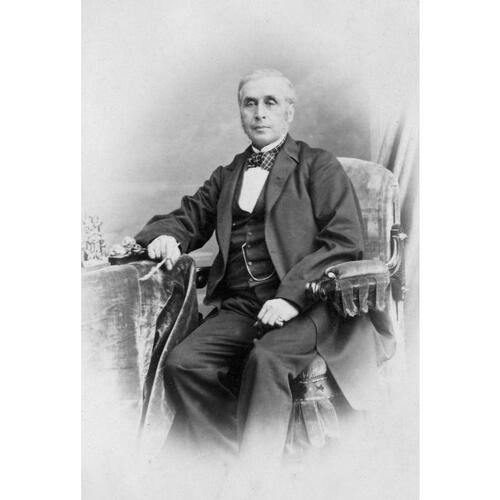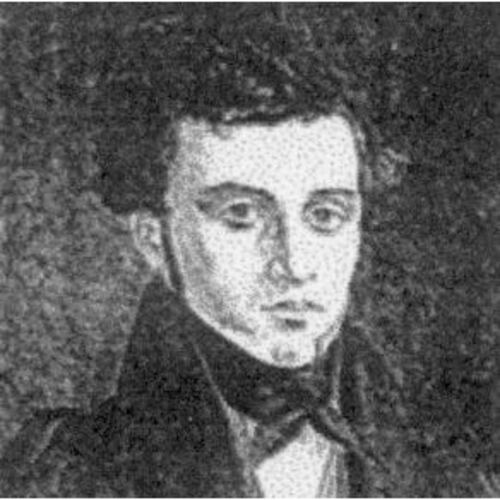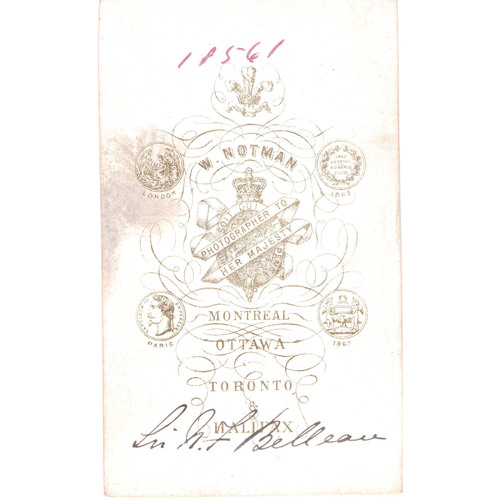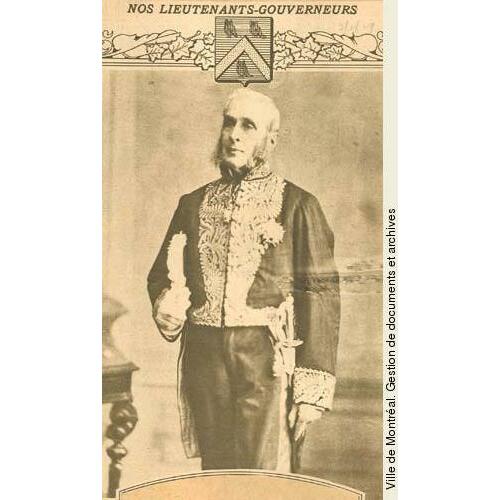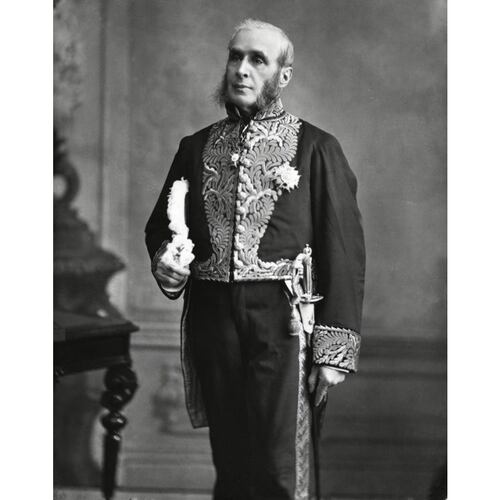
Source: Courtesy of Wikimedia Commons
BELLEAU, Sir NARCISSE-FORTUNAT (baptized Narcisse), lawyer, politician, businessman, and office holder; b. 20 Oct. 1808 at Quebec, son of Gabriel Belleau, a farmer, and Marie-Renée Hamel; m. 15 Sept. 1835 in Berthier (Berthier-sur-Mer), Lower Canada, Marie-Reine-Josephte Gauvreau, daughter of Louis Gauvreau*, a merchant; they had no children; d. 14 Sept. 1894 at Quebec.
Narcisse-Fortunat Belleau did his classical studies at the Petit Séminaire de Québec from 1818 to 1827. He was articled in April 1827 to Joseph-François Perrault* and Edward Burroughs, protonotaries at the Court of King’s Bench. He continued his training with André-Rémi Hamel from November 1829 until he was licensed to practise law on 26 Sept. 1832. At that time there was a severe outbreak of cholera at Quebec. Death often came suddenly and left difficult problems of inheritance which members of the legal profession turned to their advantage. According to his biographer, Stanislas Drapeau, Belleau acquired clients during this period who remained faithful to him over many long years.
Soon well off financially, Belleau was married on 15 Sept. 1835. He moved to Rue Saint-Louis and devoted himself to the practice of law. His political career was launched in January 1848, when he ran unsuccessfully as the Reform candidate in Portneuf. That year he was active in the Reform party and supported Joseph-Édouard Cauchon* against Louis-Joseph Papineau*, who was calling for the abolition of the union of Upper and Lower Canada. Belleau also took an interest in municipal affairs. On 9 Feb. 1848 he was elected city councillor for Saint-Jean ward. Two years later he became mayor of Quebec, an office he held until 4 Feb. 1853. During his mayoralty major work was done on water mains. The council turned to George R. Baldwin, an American engineer who had previously supervised the installation of gas lights in the city. Baldwin decided to build a dam and a water-tower in Jeune-Lorette (Wendake), at the outlet of Lac Saint-Charles, and to lay pipes to Quebec. Drinking water came to the city in 1852. Belleau also proposed to build a sewer system and pave all the streets that had been torn up to install the water pipes.
Belleau had become a director of the Quebec Bank in 1848 and remained one until 1893. According to Drapeau, he always considered requests for a discount “taking into account the likelihood of the borrower’s solvency, regardless of race or religion.” In 1859 he accepted the presidency of the North Shore Railway Company, which was supported by businessmen who wanted to link Quebec and Montreal. His friends in the Reform party did not forget him. On 23 Oct. 1852 he was appointed a life member of the Legislative Council for the division of Quebec and on 18 Dec. 1854 he was made a qc. He became bâtonnier of the Quebec bar on 1 May 1857.
Influential in his region, Belleau was a man capable of sizing up a situation, moderate in his thinking and affable in his manner, qualities that earned him the respect of his opponents. John A. Macdonald and George-Étienne Cartier*, anxious to strengthen their ministry, named him speaker of the Legislative Council on 26 Nov. 1857 and thus he was also a member of the Executive Council. Macdonald and Cartier were defeated on 29 July 1858, but returned to power on 6 August and reappointed Belleau to the speakership. Belleau was in charge of arrangements for the visit of the Prince of Wales in the summer of 1860. On 21 August, during a reception in the hall where the Legislative Council held its sessions, the prince conferred a knighthood on him.
In March 1862 Belleau became minister of agriculture and statistics, but on 21 May the Macdonald–Cartier government was defeated. Belleau continued to sit on the Legislative Council and devoted his time to his profession and to the administration of the Quebec Bank. Since 1858 he had been in partnership with Philippe-Jacques Jolicœur and they practised law together until 1863. In February 1865, during the council’s debate on the Quebec resolutions, he strongly supported the proposal for confederation, convinced that the French Canadians in Lower Canada would flourish within this constitutional framework. The death in July 1865 of Premier Sir Étienne-Paschal Taché*, the leader of the coalition preparing for confederation, brought him back into the limelight. George Brown*, Macdonald, and Antoine-Aimé Dorion, the triumvirate who held the real power, reached an agreement to make him the successor to Taché. Until 1 July 1867, then, Belleau was officially premier and receiver general. As a reward for his services, Macdonald and Cartier had nominated him for a seat in the Senate in May 1867. He withdrew, however, on accepting appointment as lieutenant governor of the province of Quebec on 1 July.
The first French Canadian to represent the British crown, Belleau remained in office until February 1873. Instead of moving to Spencer Wood, the lieutenant governor’s residence, he chose to continue living at his home on Rue Saint-Louis. He paid out of his own pocket the expenses involved in carrying out his duties. He and Lady Belleau took part in all the receptions and state dinners. But the post was far from just a symbolic one. As lieutenant governor, he kept watch for the federal government over the provincial administration. A believer in provincial autonomy within confederation, he soon became disenchanted. The tensions between Cartier and Hector-Louis Langevin*, as well as between Pierre-Joseph-Olivier Chauveau* and the provincial ministers, over the conduct of public affairs and of the Conservative party led him to intervene behind the scenes. In a long letter to Langevin in April 1869, he accused the federal ministers of being autocrats jealous of their power and bent on splitting hairs. He suggested that they always interpreted to the advantage of the central government the division of powers provided for in the constitution. He begged Langevin to give “the benefit of the doubt to the provincial jurisdictions” and not, “by deduction, by inference and conclusion,” to impute additional powers to the federal government.
When his term was up on 11 Feb. 1873, Sir Narcisse-Fortunat Belleau retired. He refused a seat in the Senate. He continued to sit on the board of the Quebec Bank and took an active part in social functions. He still followed the political scene closely and did not hesitate to use his influence from time to time. On 24 May 1879, in Montreal, he was made a kcmg. He died on 14 Sept. 1894, leaving his fortune, which contemporaries estimated at between $200,000 and $300,000, to a nephew.
ANQ-Q, CE1-1, 20 oct. 1808, 18 sept. 1894; CE2-2, 15 sept. 1835; P-3; P-134. ASQ, Fichier des anciens. Le Canadien, 13 déc. 1847. Le Courrier du Canada, 14 sept. 1894. L’Événement, 15 sept. 1894. Gazette (Montreal), 15 Sept. 1894. La Minerve, 17 sept. 1894. Audet, “Les législateurs du Bas-Canada.” J. Desjardins, Guide parl. Political appointments, 1841–65 (J.-O. Coté; 1866). Quebec directory, 1847–92. RPQ. Turcotte, Le Conseil législatif. Chouinard et al., La ville de Québec, vol.3. L.-M. Côté et al., Les maires de la vieille capitale. Désilets, Hector-Louis Langevin. Stanislas Drapeau, Biographie de sir N. F. Belleau . . . (Québec, 1883). Henry Fry, A biographical sketch of Sir N. F. Belleau from “Home Journal,” for October 1894 (Quebec, 1894). M. Hamelin, Premières années du parlementarisme québécois. Rumilly, Hist. de la prov. de Québec, vol.1. Alastair Sweeny, George-Étienne Cartier: a biography (Toronto, 1976). F.-J. Audet et al., “Les lieutenants-gouverneurs de la province de Québec,” Cahiers des Dix, 27 (1962): 215–16.
Cite This Article
Michèle Brassard and Jean Hamelin, “BELLEAU, Sir NARCISSE-FORTUNAT (baptized Narcisse),” in Dictionary of Canadian Biography, vol. 12, University of Toronto/Université Laval, 2003–, accessed January 1, 2026, https://www.biographi.ca/en/bio/belleau_narcisse_fortunat_12E.html.
The citation above shows the format for footnotes and endnotes according to the Chicago manual of style (16th edition). Information to be used in other citation formats:
| Permalink: | https://www.biographi.ca/en/bio/belleau_narcisse_fortunat_12E.html |
| Author of Article: | Michèle Brassard and Jean Hamelin |
| Title of Article: | BELLEAU, Sir NARCISSE-FORTUNAT (baptized Narcisse) |
| Publication Name: | Dictionary of Canadian Biography, vol. 12 |
| Publisher: | University of Toronto/Université Laval |
| Year of publication: | 1990 |
| Year of revision: | 1990 |
| Access Date: | January 1, 2026 |




